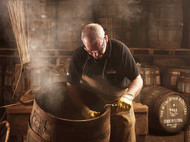THE IMPORTANCE OF OAK
7th Aug 2019
Traditional distillers use oak from different locations across the globe to make casks. Oak Casks are a master Distiller’s most powerful tool because the time spent maturating in casks is what adds the complex layering of flavours, aromas, colours and textures.
Making a cask isn’t a simple process and is a highly skilled and traditional art called coopering. A cooper uses different types of oak to make differing sized casks for distilleries. In order to create balanced and delicious malts, Master Distiller’s usually hand select each cask that will be used and for how long.
"With 60-80% of the rich flavours of our (The Glenlivet’s) whiskies coming from oak casks, coopers play an integral role in creating the heady aromas and lingering finishes of our most popular single malts." - ALAN WINCHESTER, MASTER DISTILLER, THE GLENLIVET
ALL ABOUT OAK
Oak is the primary choice for casks because it is both flexible and solid. There are three main types of oak used for whisky casks:
Traditional European oak (Quercus rober or Quercus patraea)
European oak grows across the entire European content as well as Turkey and Russia. European Oak Casks add spicy and woody flavours alongside a slight dryness from the pseudo-tannin Gallic acid in the wood.
White American oak (Quercus alba)
American white oak grows in Eastern USA as well as small regions in Canada. The dense wood contains vanillins which add creamy, coconut and of course vanilla notes in the whisky. Alba mellows and softens the spirit.
Japanese Oak (Quercus mongolica)
Japanese Oak is typically only used in Japan for the
production of Japanese malts. It is commonly referred to as Mizunara Oak.
Achieving the perfect balance of these natural flavours is a tricky business as
too much tannins, lignins and vanillins from virgin oak can dominate a spirit’s
maturation. To offset the strength of these flavours many distilleries mainly
use casks that have previously aged other spirits or wines, such as bourbon or
sherry. This also impacts on flavour: ex-bourbon casks, for example, make the
whisky more sweet and creamy with caramel and vanilla notes; while Oloroso
Sherry casks add deep, nutty and dark ripe fruit flavours.
The oak’s effect on the spirit inside decreases over time and use, so how many
times a cask has been refilled also impacts on the flavour.
SIZE OF CASK
Coopers typically adhere to traditional sizes unless a distillery or winery has specific requirements. The most common sizes for whisky ageing are barrels are
- 200 litre casks used to age bourbon
- Hogsheads, sometimes referred to as ‘hoggies’ that store 250 litres of new-make spirit
- Butts are the biggest cask size containing 500 litres and have normally been used to mature sherry.
Smaller whisky casks mature faster than larger barrels as more liquid encounters the wood surface. When considering the maturation process, Master Distillers takes the cask size into account. For example, Alan Winchester matures The Glenlivet Master Distiller’s Reserve in butts, barrels and hogsheads to develop the perfect balance of flavours.
MAKING A CASK
To make a cask, Coopers source oak planks usually from a sawmill which are then cut to the correct size to make staves. Staves are small curved planks that when linked together to form a circular barrel. These are bent into shape using fire. Casks are traditionally made from 32 staves, with 15 more used to seal the ends. Once in the perfect shape coopers plane down the staves rather than nailing or gluing them and metal hoops are used to hold them together. The oak is never varnished or painted as this blocks the woods porous qualities which prevents the whisky from interacting with air during ageing.
ALL FIRED UP
In order to convert the wood sugars into vanilla and caramel flavours, Coopers burn the insides of casks. The more charring, the stronger the vanilla flavours. The carbon from the burned layer also acts like a filter to remove various impurities, such as sulphur compounds, from the spirit. Once the coppers char the casks they are handed over to the distillery.

